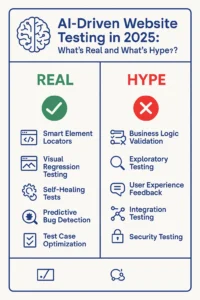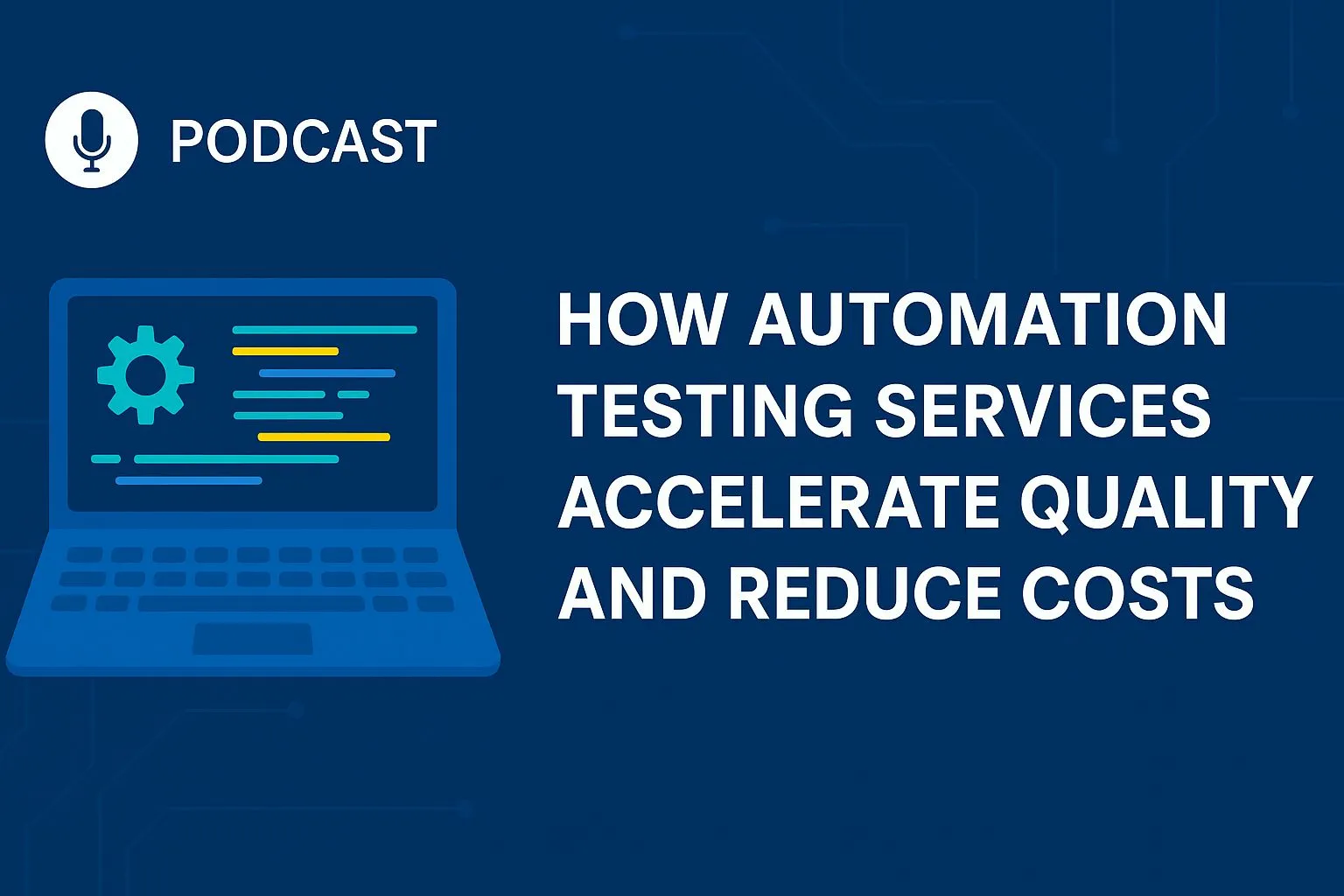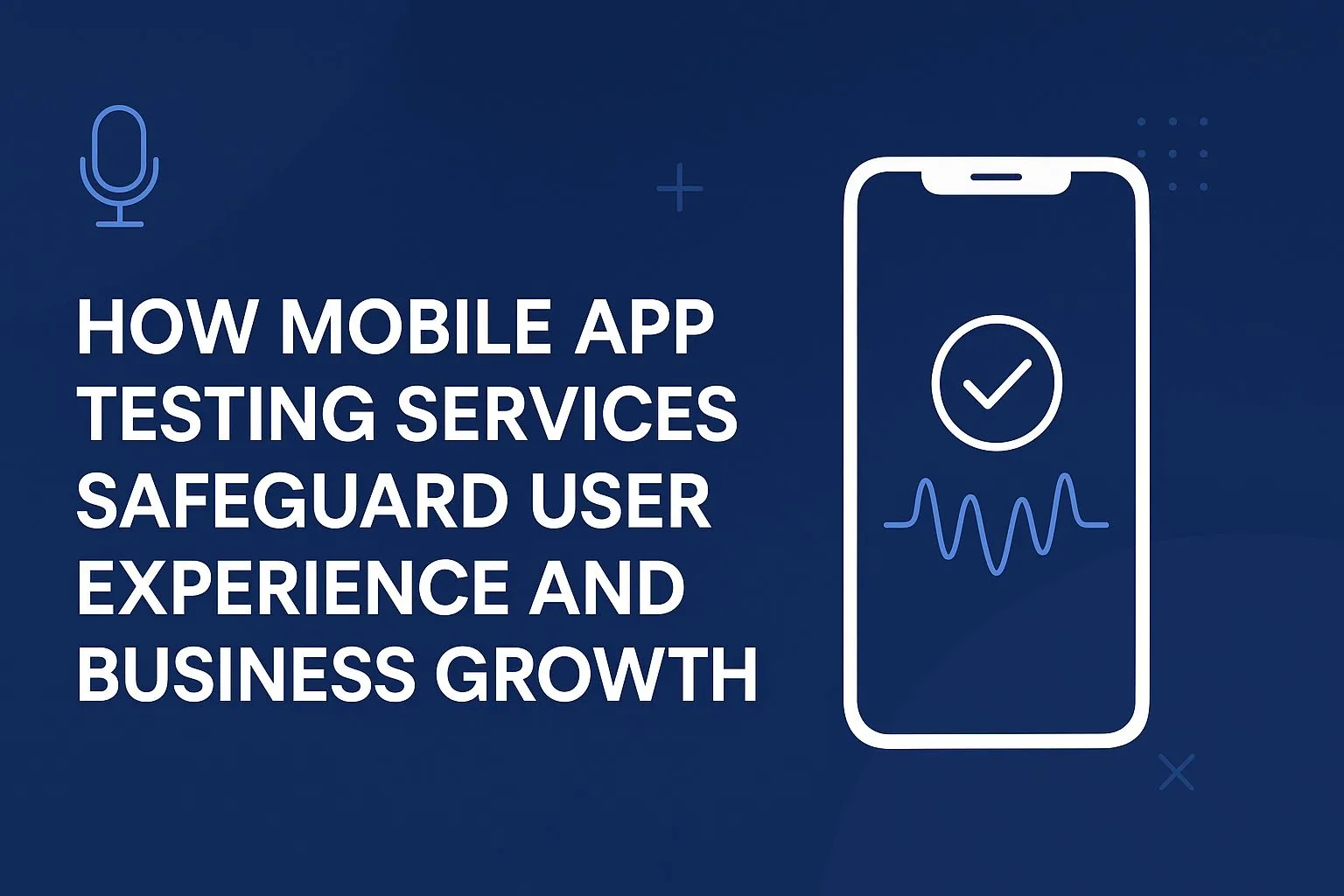AI-Driven Website Testing in 2025: What’s Real and What’s Hype?
AI has changed almost every part of software development in the last few years, and website testing is no different. As we enter 2025, QA teams and digital product owners are looking more and more into AI-based website testing tools to speed up cycles, cut down on human errors, and cover more tests.
But here’s the big question: Is AI really as great as people say it is?
AI can definitely make the QA process faster and smarter, but it’s important to know the difference between what it can do and what it has been promised it can do. In this blog, we’ll talk about what AI-driven website testing really does, where it doesn’t work, and how your business can benefit from it if you use it wisely.
🤖 What does AI-driven website testing mean?
AI-driven website testing means using machine learning algorithms, computer vision, natural language processing (NLP), and data models to make the testing process faster and easier. AI-based tools, on the other hand, can adapt to changes in the UI, predict how users will act, and even find bugs across versions. Traditional test automation, on the other hand, follows hard-coded scripts.
An AI tool, on the other hand, could recognize layout changes visually, compare snapshots, and flag inconsistencies without any help from people after it is set up.
Do you want to use AI to automate testing on your website?
⚙️ What AI Can Really Do for Website QA (Right Now)
AI-powered tools will be able to help with a lot of testing tasks by 2025, especially visual testing and regression analysis. These are some real benefits:
- Smart Element Locators: AI is used by tools like Testim and Mabl to keep test scripts up to date even when the DOM structure changes.
- Visual Regression Testing: Computer vision automatically finds differences between builds that people can see.
- Self-healing Tests: AI can change selectors on the fly if a button label or class changes.
- Predictive Bug Detection: Tools can use past test data to find the most dangerous parts of code or UI.
- Test Case Optimization: AI can suggest which test cases to run based on code changes, which saves time.
These benefits make maintenance a lot easier, especially for big websites that change their UI often.
🛑 Things AI Can’t Do Well Right Now
AI tools are getting better, but they can’t completely take the place of automated testing that is done by hand or with scripts. This is still hard for AI:
- Validation of Business Logic: AI can’t figure out your unique workflows or test edge cases on its own.
- Exploratory Testing: The best way to find weird behavior is to go with your gut.
- User Experience (UX) Feedback: AI can only see patterns; it doesn’t know what “intuitive” or “confusing” means.
- Integration Testing: You still have to write your own code to find out how third-party APIs or systems work.
- Security Testing: Vulnerability scans need special tools and a human review in addition to AI automation.
AI can speed up QA, but it can’t take the place of QA experts, especially in fields like healthcare, fintech, or eCommerce.
👉 Do you need help figuring out how to use AI tools and human QA together?
🔍 Where AI Really Shines: Examples That Work
Let’s see where AI is already making a difference in real-world website testing:
1. AI in Testing Visuals
AI-powered platforms like Percy, Applitools, and LambdaTest look at how pages are laid out and how pixels change across different browsers and devices. Instead of matching pixels one by one, they use smart detection to find real layout problems and avoid false positives.
2. Making Test Cases with AI
TestRigor and Functionize are two tools that turn plain English instructions into test scripts. This lets people who aren’t developers help with QA by describing how users move through the site. AI takes care of the rest.
3. AI to Cut Down on Maintenance
Self-healing algorithms let tools find renamed selectors, moved elements, or dynamic IDs and automatically update the scripts without any work from people.
4. More intelligent test coverage
AI systems look at user behavior data (like heatmaps and sessions) to figure out which test cases to focus on, such as high-traffic areas or important funnels (like checkout).
🧪 Example from the real world: One of our eCommerce clients used AI-based visual comparison tools on websites in 15 countries to cut down on manual regression cycles by 42%.
🔧 Popular AI Testing Tools in 2025
Here are the leading platforms that QA teams are adopting in 2025:
Tool |
What It Does |
| Applitools | Visual AI testing for cross-browser layouts |
| Mabl | Low-code test automation with auto-healing |
| testRigor | English-to-test case converter |
| Functionize | Cloud-based, NLP-driven automation |
| Percy by BrowserStack | Smart visual regression testing |
Before adopting, it’s essential to evaluate pricing, team skill levels, and integration with CI/CD pipelines.
👉 CTA: Want help choosing the right AI testing tool?
🧠 AI and human testers work well together.
Smart QA leaders aren’t seeing AI as a replacement; instead, they’re coming up with hybrid strategies that use both human insights and AI automation. This is how this synergy works:
- People come up with the plan, and AI does the same things over and over.
- People look into edge cases, while AI checks for regressions.
- People look at the user experience (UX), and AI looks for problems with the layout.
- People check logic, and AI makes sure scripts don’t break.
This way of working together helps businesses grow faster while still making sure the tests are accurate and complete.
🔮 What Comes Next? The Future of AI in Website Quality Assurance
In the future, we can expect more personalized experiences, more predictive insights, and low-code QA platforms that are completely powered by AI. Test suites could soon be made on the fly based on user analytics, release patterns, and past bugs, which would require very little work from testers.
But issues like bias in AI models, too much reliance on black-box systems, and not understanding the context will still be important to deal with.
In the end, the companies that use AI tools and human knowledge together will have the strongest QA pipelines.
✅ Final Thoughts: Is it Hype or Helpful?
AI-driven website testing isn’t just a buzzword anymore; it’s changing how quality assurance works. Still, it’s not magic. It still needs human judgment, strategy, and oversight, even though it speeds up visual checks, makes tests more stable, and cuts down on test maintenance.
If you’re thinking about using AI for testing, start with a small project. Pick one tool, test it on a specific module, and see how much money it really makes before you use it on a larger scale.
💡 FAQ – AI in Website Testing
Q1: Can AI testing tools take the place of human testers entirely?
No. Automated tests do a lot of things, but human testers are still needed to check logic, user experience, and exploratory flows.
Q2: What are the best AI tools for checking websites in 2025?
Some of the best tools are Applitools, Mabl, testRigor, Percy, and Functionize. Each one has its own strengths.
Q3: Is testing with AI good for small businesses?
Yes! A lot of tools have plans that are easy on the wallet. Depending on what you need, you can start with AI-driven visual testing or low-code automation.
Q4: Can AI help with testing performance or load?
AI can find the best test paths or guess where the bottlenecks will be, but to do full performance/load testing, you still need tools like JMeter or k6.
Q5: How do I find a balance between AI automation and manual testing?
Use AI to check for regressions and layout problems. Make sure that manual testers stay focused on edge cases, integrations, and UX flows.











